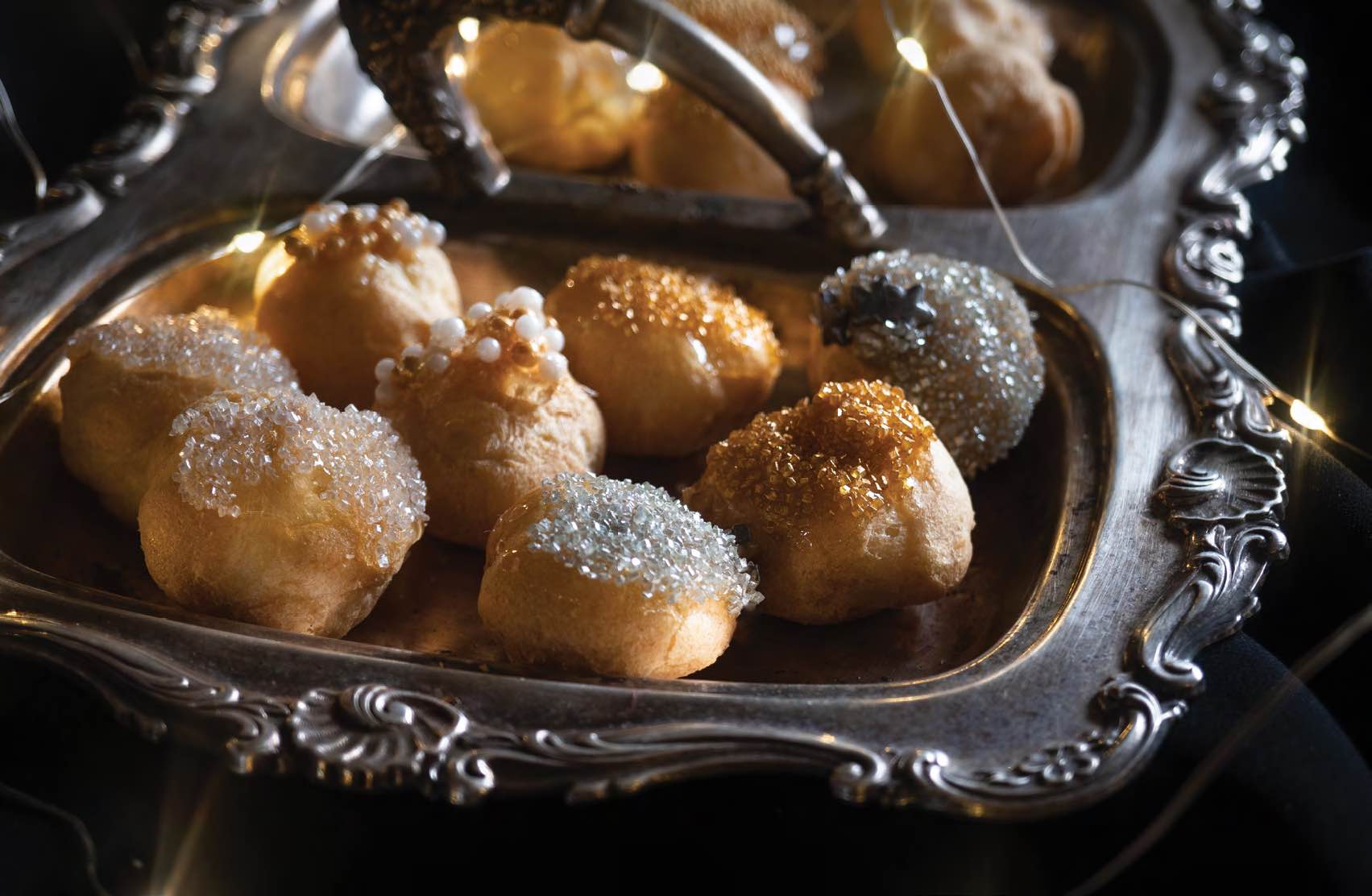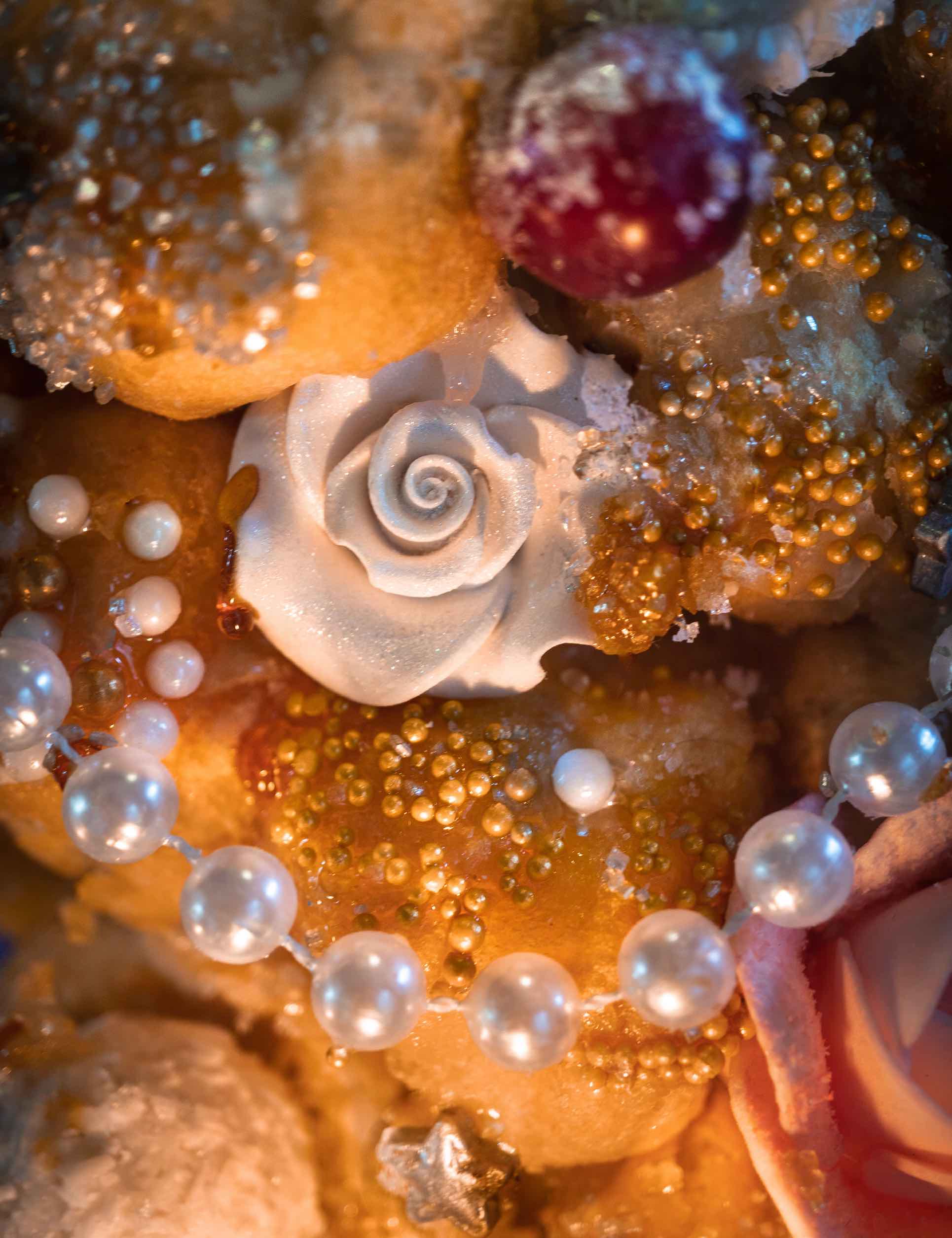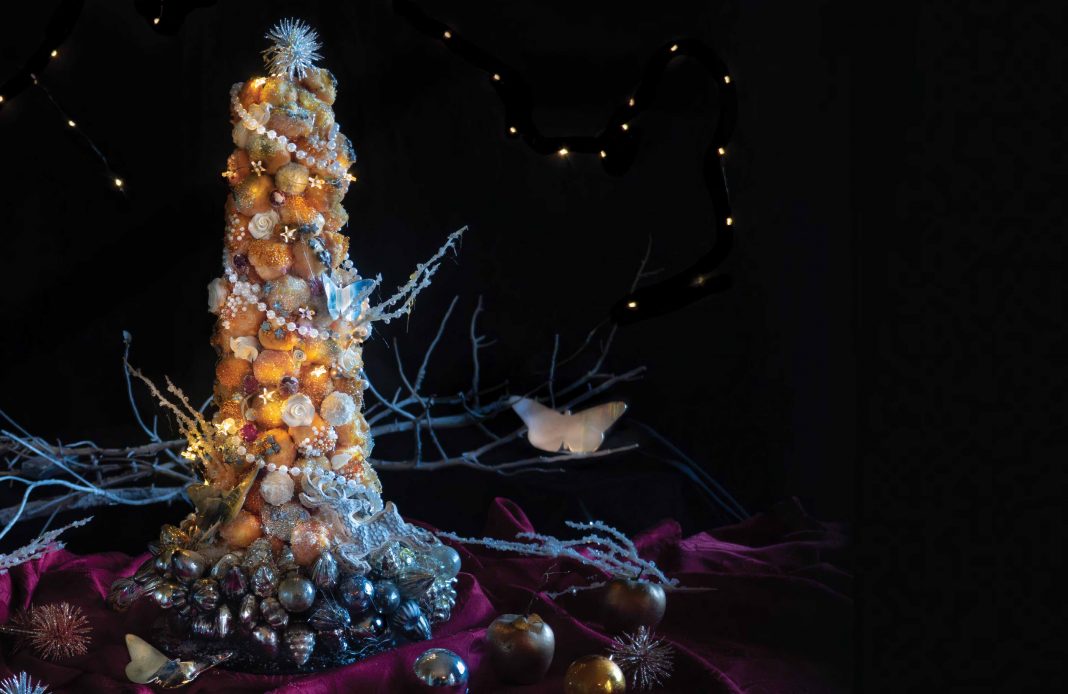RECIPE AND PHOTOGRAPHY BY DANIELLE PROHOM OLSON (A.K.A. GATHER VICTORIA)
What could be more decadent than a lofty spire of cream puffs magically held together with caramelized sugar and studded with rose fondant, white chocolate truffles, marzipan stars, and gleaming sugar pearls? Inspired by the adage “art for art’s sake,” this croquembouche is in the tradition of the grand desserts once served in the glittering salons and aristocratic banquet halls of 19th century Paris. French chefs painstakingly crafted towering centerpieces of confectionery art known as pièces montés (mounted pieces) from individual pastries and candied sugar. The inventor of the croquembouche, the great chef Antonin Carême, believed architecture to be the most noble of the arts and pastry the highest form of architecture. Adorned with sugar-coated fruits, almonds, flowers, fondant, and spun sugar, these elaborate creations were meant more to be marveled at than consumed.
The croquembouche is still a starring cake at many French special occasions—most especially weddings—but unlike its predecessors it is definitely meant to be eaten and enjoyed. I’m French on my father’s side, and at my wedding a chef in a tall white hat with a twirling Hercule Poirot moustache created and unveiled a towering classic croquembouche. While the guests weren’t quite sure what it was, all gasped in awe as it glowed and shimmered in a traditional golden cloud of spun sugar. The croquembouche is generally broken up, and guests are invited to help themselves. In some wedding traditions, the top of the croquembouche is dramatically broken off with a silver mallet or a champagne bottle, while bridesmaids hold up the corners of the table cloth to catch the pieces.

Despite its extravagant exterior, the croquembouche is at heart a simple sensual pleasure. Classic French chou à la crèmes (pastries or éclair puffs filled with sweet cream) are topped with the delightful crunch of caramelized sugar. This is how the croquembouche got its literal name: “crunch in the mouth.” And it’s best eaten one chou at a time with your fingers; that way the cream will explode in your mouth and not be wasted on the plate.
Today the croquembouche comes in countless variations, like chocolate truffle and brandy croquembouche; chestnut, fig, and ginger croquembouche; orange-anise croquembouche; rose and white chocolate croquembouche, to name but a few.
If you think a croquembouche is too much work, this quick version is an easy and fun way to create a spectacular holiday dessert. No need to make cream puffs from scratch—all you need is a big tub of frozen profiteroles from the grocery store. Profiteroles are the American version of chou à la crème, and while you may not experience the exquisite culinary pleasures of a croquembouche created fresh by a French pastry chef, it still tastes delicious! Plus, choux pastries are best left to the experts. Better store-bought in my case than a homemade disaster.
“All shimmering and purple and gold” is how the French writer Paul Verlaine described the word decadent. So for my winter croquembouche I headed over to the baking aisle and stocked up on shimmery sugar sprinkles, sparkly little stars, golden and ivory sugar pearls, and glittering sanding sugars. Then from the confectionary section I added white chocolate truffles, pretty shiny sweets, and fondant white roses. At home, I raided my holiday boxes for ornaments and wintery decorations.
Once I had all the components assembled, I began by making the caramel syrup. Simmering sugar and water on a mid-boil until it turned a thick golden brown, this was the glue I used
to stick the profiteroles together and to dip in the glittering toppings. I decided to skip the candied halo spun sugar that traditionally surrounds the croquembouche. Flinging searing hot syrup around with a whisk or a fork is another activity best left to the experts.
Dipping and building, I set to work, but when it came to decorating, I allowed the muses of decadence to guide the way. Just a little more—everything! Carême would be disappointed in my architectural pastry skills, but I think the final bejeweled result has a certain lopsided je ne sais quoi. And while I didn’t plan it, my croquembouche decorated with lights, flowers, stars, and ornaments shimmers like a seasonal tree in the wintry dark. It may be far from pastry perfection, but I love how the spirit of the holiday season shines right through.

RECIPE FOR WINTER HOLIDAY CROQUEMBOUCHE
Ingredients
• 1 large tub of frozen profiteroles (2.2 lbs)
• 10 ounces white granulated sugar
• 4 ounces water
• 2 tablespoons corn syrup (optional)
• ½ teaspoon lemon juice
• Assortment of sprinkles and candy decorations of your choice
• Glitter—how much is up to you, but I used nearly ¾ cup total to adorn my croquembouche.
• Assortment of confectioneries of your choice: chocolate, candied almonds, fondant flowers, sugared fruits and berries, etc. Again, the amount used is up to you.
DIRECTIONS
Remove your tub of profiteroles from the freezer about a half hour before beginning. You don’t want them completely frozen or completely defrosted—somewhere in between.
To Make Caramel Glaze:
While many modern recipes call for corn syrup I made mine the traditional way, with just sugar and water. I used a pastry brush dipped in lemon to wash the sides of the mixture to prevent sugar crystals from developing. Depending on the size of your croquembouche you may need to make two batches of glaze.
Mix the sugar with water in a heavy saucepan. Add corn syrup if you wish.
Place the saucepan over medium flame and bring to a gentle boil. Do not stir.
As the mixture thickens and turns into a syrup, take a pastry brush dipped in lemon juice (or cold water) and wash the sides of the saucepan. Cook the sugar syrup until it’s golden and thick. Remove from heat and let it cool a few minutes before assembling your croquembouche.
ASSEMBLY
Part One:
Start by dipping the bottoms of your profiteroles in the syrup and attach them to a cake plate or round serving dish. Depending on the size of your profiteroles and your plate, you will use from 10 to 14. Arrange in the form of a circle and fill it in with more puffs until you have the round base to build upon.
Part Two:
Once your base is laid down, begin dipping your puffs in the caramel, then dip them in your assorted candy decorations. These will be your glittery tops. Place on a large sheet of parchment or wax paper and let dry and harden.
Part Three:
By this time, you will need to gently rewarm your syrup, which will have hardened. Keep the heat low: From this point on, the sugar will begin to darken and burn easily.
Once melted, dip the bottoms of your decorated profiteroles into the caramel and place on top of your base layer. Think of it as a cone (wide at the bottom and narrowing at its top). If you start with a base of 12 puffs, keep adding fewer puffs as you build—i.e., the next layer will be 11, the next 10, and so on. Pair the puffs by size, using the bigger puffs at the bottom and reserving the smaller ones for the top.
Part Four:
Once your croquembouche is built, it’s time to decorate it. You should have just enough caramel left over to attach the rest of your goodies, chocolate, candied almonds, fondant flowers, marzipan—whatever you’ve chosen.
The croquembouche is best made the day of your celebration and served fresh because the spun sugar and caramel can absorb moisture and begin to soften and melt, as I discovered when taking these pictures. If you look carefully, you can see places where the puffs have fallen right out!




































